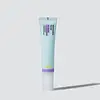What's inside
What's inside
 Key Ingredients
Key Ingredients

 Benefits
Benefits

 Concerns
Concerns

No concerns
 Ingredients Side-by-side
Ingredients Side-by-side

Ethylene Brassylate
MaskingCyclopentasiloxane
EmollientTocopheryl Acetate
AntioxidantBHT
AntioxidantPolymethylsilsesquioxane
Disodium EDTA
Glycerin
HumectantCaprylyl Glycol
EmollientCaprylhydroxamic Acid
Propylheptyl Caprylate
EmollientSorbitan Olivate
EmulsifyingCetearyl Olivate
Hydroxymethoxyphenyl Decanone
Skin ConditioningBisabolol
Masking4-T-Butylcyclohexanol
MaskingPentylene Glycol
Skin ConditioningEthylhexyl Olivate
Skin ConditioningLecithin
EmollientSodium Acrylates Copolymer
Water
Skin ConditioningEthylene Brassylate, Cyclopentasiloxane, Tocopheryl Acetate, BHT, Polymethylsilsesquioxane, Disodium EDTA, Glycerin, Caprylyl Glycol, Caprylhydroxamic Acid, Propylheptyl Caprylate, Sorbitan Olivate, Cetearyl Olivate, Hydroxymethoxyphenyl Decanone, Bisabolol, 4-T-Butylcyclohexanol, Pentylene Glycol, Ethylhexyl Olivate, Lecithin, Sodium Acrylates Copolymer, Water
Water
Skin ConditioningSorbitol
HumectantCaprylic/Capric Triglyceride
MaskingCoco-Caprylate
EmollientMangifera Indica Seed Butter
Skin ConditioningNiacinamide
SmoothingCitrullus Lanatus Seed Oil
EmollientSqualane
EmollientEthylhexyl Stearate
EmollientAmmonium Polyacryloyldimethyl Taurate
Emulsion StabilisingCaprylyl Glycol
EmollientIsoamyl Cocoate
Beta-Glucan
Skin ConditioningTocopherol
AntioxidantBisabolol
Masking1,2-Hexanediol
Skin ConditioningAcrylates/C10-30 Alkyl Acrylate Crosspolymer
Emulsion StabilisingPentaerythrityl Tetra-Di-T-Butyl Hydroxyhydrocinnamate
AntioxidantGlycerin
HumectantCaprylhydroxamic Acid
Sodium Gluconate
Skin ConditioningCI 42090
Cosmetic ColorantSodium Benzoate
MaskingWater, Sorbitol, Caprylic/Capric Triglyceride, Coco-Caprylate, Mangifera Indica Seed Butter, Niacinamide, Citrullus Lanatus Seed Oil, Squalane, Ethylhexyl Stearate, Ammonium Polyacryloyldimethyl Taurate, Caprylyl Glycol, Isoamyl Cocoate, Beta-Glucan, Tocopherol, Bisabolol, 1,2-Hexanediol, Acrylates/C10-30 Alkyl Acrylate Crosspolymer, Pentaerythrityl Tetra-Di-T-Butyl Hydroxyhydrocinnamate, Glycerin, Caprylhydroxamic Acid, Sodium Gluconate, CI 42090, Sodium Benzoate
 Reviews
Reviews

Ingredients Explained
These ingredients are found in both products.
Ingredients higher up in an ingredient list are typically present in a larger amount.
Bisabolol is famous for its skin soothing properties. It does this by blocking inflammatory signals, helping to reduce your body's reaction to irritation.
This ingredient also interferes with the process of hyperpigmentation. This can help with reducing dark spots and uneven tone.
Bisabolol is an antioxidant. Antioxidants help fight free-radicals. Free-radicals are molecules that may damage your skin cells. By fighting these free-radicals, Bisabolol may slow down signs of aging.
Studies have shown Bisabolol to have antimicrobial properties and may be a fungicide. These properties help preserve a product's shelf life.
All these properties makes bisabolol a great skin barrier helper ingredient.
Bisabolol also helps the absorption of other ingredients.
Note: Synthetic Bisabolol has been shown to be less effective.
Learn more about BisabololCaprylhydroxamic Acid is a chelating agent.
Chelating agents help prevent metal ions from binding to other ingredients. This helps prevent unwanted reactions and effects from using the product.
Caprylhydroxamic Acid is often used with natural antimicrobial products as an alternative to preservatives.
Learn more about Caprylhydroxamic AcidCaprylyl Glycol is a humectant and emollient, meaning it attracts and preserves moisture.
It is a common ingredient in many products, especially those designed to hydrate skin. The primary benefits are retaining moisture, skin softening, and promoting a healthy skin barrier.
Though Caprylyl Glycol is an alcohol derived from fatty acids, it is not the kind that can dry out skin.
This ingredient is also used as a preservative to extend the life of products. It has slight antimicrobial properties.
Learn more about Caprylyl GlycolGlycerin is already naturally found in your skin. It helps moisturize and protect your skin.
A study from 2016 found glycerin to be more effective as a humectant than AHAs and hyaluronic acid.
As a humectant, it helps the skin stay hydrated by pulling moisture to your skin. The low molecular weight of glycerin allows it to pull moisture into the deeper layers of your skin.
Hydrated skin improves your skin barrier; Your skin barrier helps protect against irritants and bacteria.
Glycerin has also been found to have antimicrobial and antiviral properties. Due to these properties, glycerin is often used in wound and burn treatments.
In cosmetics, glycerin is usually derived from plants such as soybean or palm. However, it can also be sourced from animals, such as tallow or animal fat.
This ingredient is organic, colorless, odorless, and non-toxic.
Glycerin is the name for this ingredient in American English. British English uses Glycerol/Glycerine.
Learn more about GlycerinWater. It's the most common cosmetic ingredient of all. You'll usually see it at the top of ingredient lists, meaning that it makes up the largest part of the product.
So why is it so popular? Water most often acts as a solvent - this means that it helps dissolve other ingredients into the formulation.
You'll also recognize water as that liquid we all need to stay alive. If you see this, drink a glass of water. Stay hydrated!
Learn more about Water